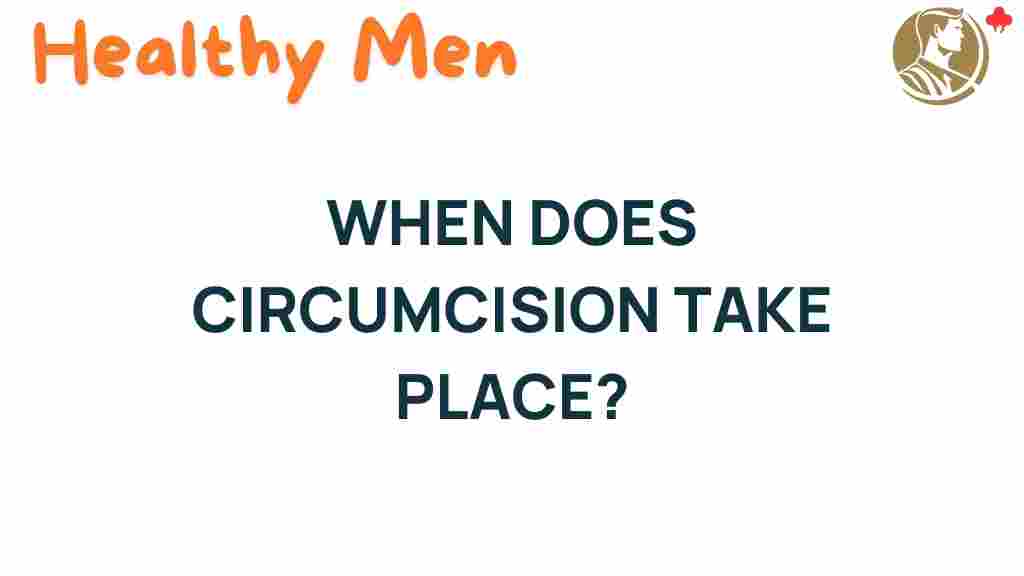Unveiling the Timing: When Does Circumcision Really Happen?
Circumcision is a significant medical procedure that has been practiced for centuries across various cultures. The timing of circumcision can vary based on medical, cultural, and personal factors. In this article, we will delve into the various aspects of circumcision, focusing on its timing, parental decisions, and its implications for newborn care and infant health.
Circumcision: Understanding the Basics
Before discussing the timing of circumcision, it’s essential to understand what the procedure entails. Circumcision involves the surgical removal of the foreskin, which is the fold of skin covering the glans (head) of the penis. This practice is often performed for a variety of reasons, including:
- Religious beliefs and cultural traditions
- Health benefits
- Hygienic reasons
- Parental preferences
The Historical Context
The roots of circumcision can be traced back to ancient civilizations. In many cultures, it is associated with significant rites of passage. For example, in Judaism, circumcision is performed on the eighth day after birth, a tradition known as the “Brit Milah.” In contrast, some communities in Africa and the Middle East practice circumcision for cultural reasons, often at various ages.
The Timing of Circumcision
When it comes to the timing of circumcision, several factors can influence the decision. The two most common periods for circumcision are:
- Newborn Period: Usually performed within the first few weeks of life, typically within the first 2-10 days.
- Later Childhood or Adolescence: Some parents choose to delay circumcision until the child is older, allowing them to participate in the decision.
Newborn Circumcision: A Step-by-Step Process
For parents considering circumcision for their newborn, understanding the process can alleviate concerns and ensure informed decision-making. Here’s a step-by-step overview of what to expect:
- Consultation with Healthcare Provider: Discuss the reasons for considering circumcision, potential risks, and benefits. This is an opportunity to ask questions regarding the procedure.
- Scheduling the Procedure: If the decision is made, the circumcision is typically scheduled within the first two weeks of birth, often before the baby leaves the hospital.
- The Procedure: Circumcision is usually performed under local anesthesia. The procedure lasts about 10-30 minutes.
- Post-Procedure Care: After circumcision, parents will receive guidance on how to care for the circumcised area to prevent infection and ensure proper healing.
Post-Procedure Care for Newborns
Proper newborn care following circumcision is crucial for infant health. Here are some tips:
- Apply a thin layer of petroleum jelly to the area to prevent the diaper from sticking.
- Change diapers frequently to keep the area clean and dry.
- Monitor for signs of infection, such as excessive bleeding or pus.
- Consult your healthcare provider if you have any concerns.
Cultural Practices Surrounding Circumcision
Circumcision is not solely a medical procedure; it is steeped in cultural practices and traditions. Different communities have distinct beliefs regarding the timing and significance of circumcision:
Religious Influences
In many religious communities, circumcision is viewed as an essential rite of passage:
- Judaism: The Brit Milah is performed on the eighth day after birth, symbolizing the covenant between God and Abraham.
- Islam: Circumcision is practiced in many Muslim cultures, often performed before the child reaches puberty, though the exact timing can vary.
Health Perspectives
Some parents choose circumcision due to health benefits that may arise, such as:
- Reduced risk of urinary tract infections (UTIs) in infancy.
- Lowered risk of sexually transmitted infections (STIs) later in life.
- Improved hygiene, as circumcised males may have fewer hygiene-related issues.
Parental Decisions: Weighing the Pros and Cons
The decision to circumcise is often a personal one, influenced by a variety of factors. Parents must weigh the benefits and risks carefully:
Pros of Circumcision
- Prevention of certain medical conditions.
- Ease of hygiene.
- Cultural and religious significance.
Cons of Circumcision
- Potential for pain and complications during the procedure.
- Risk of infection.
- Ethical considerations regarding consent, especially for infants.
Addressing Common Concerns
Many parents have concerns about circumcision. Here are some common questions and answers to help ease worries:
Is Circumcision Painful for Newborns?
While newborns may experience discomfort, the procedure is performed with local anesthesia to minimize pain. Post-operative care can further alleviate discomfort.
What Are the Risks Involved?
As with any medical procedure, there are risks, including bleeding, infection, and complications related to anesthesia. However, serious complications are rare when performed by a qualified healthcare provider.
Can Circumcision Be Reversed?
Circumcision is a permanent procedure. While some surgical techniques exist to reconstruct the foreskin, they are complex, costly, and not widely performed.
Alternative Views on Timing and Circumcision
Some parents and medical professionals advocate for a more individualized approach to circumcision. Key arguments include:
- Delaying the procedure until the child is old enough to make their own decision.
- Considering non-surgical alternatives for hygiene and health.
Healthcare Provider Recommendations
Consulting with a healthcare provider can provide valuable insights tailored to your child’s health and your family’s values. It’s essential to discuss the timing and reasons for circumcision with your pediatrician to make an informed decision.
Conclusion: Making an Informed Decision
Circumcision is a multifaceted issue that involves medical, cultural, and personal considerations. The timing of circumcision can significantly impact newborn care and infant health, making it crucial for parents to weigh their options carefully. Whether you choose to proceed with circumcision during the newborn period or consider delaying the procedure, open communication with healthcare providers and understanding the implications are essential.
Ultimately, the decision should align with your family’s values and beliefs, ensuring the best possible outcome for your child’s health and well-being. For further information on healthcare practices and parental decisions regarding circumcision, you can explore resources available through healthcare organizations and expert guidelines.
If you are looking for additional insights on cultural practices related to circumcision, check out this detailed article on cultural traditions surrounding the procedure.
This article is in the category Conditions and created by healthymen Team
